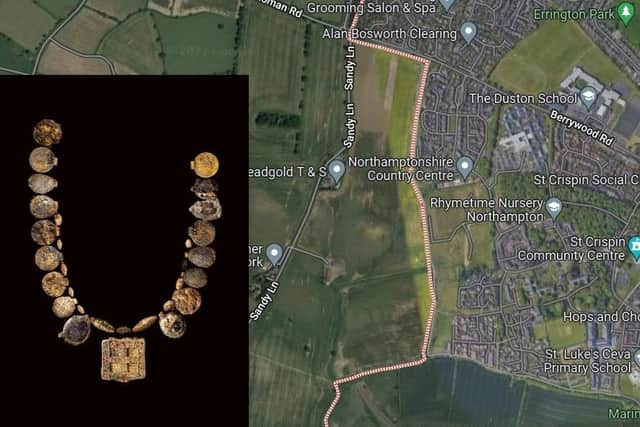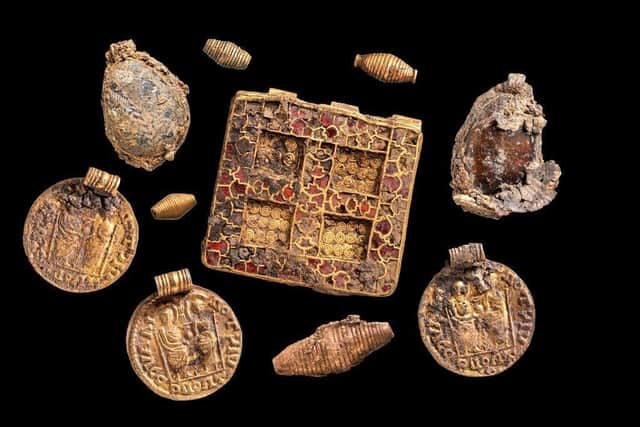'Once-in-a-lifetime' 1,300-year-old necklace found by archaeologists excavating village land near Northampton
and live on Freeview channel 276
A “once-in-a-lifetime” 1,300-year-old gold and gemstone necklace has been discovered within an 'internationally significant' female burial in a village near Northampton.
Museum of London Archaeology (MOLA) say they found the necklace during excavation works ahead of a housing development on land between Harpole and Duston.
Advertisement
Hide AdAdvertisement
Hide AdThe necklace, which dates back to 630 – 670 AD, is the 'richest of its type ever uncovered in Britain' with at least a staggering 30 pendants and beads made of Roman coins, gold, garnets, glass and semi-precious stones, architects say.


A rectangular pendant with a cross motif forms the centrepiece of the necklace and is the largest and most intricate element. Made of red garnets set in gold, MOLA specialists believe it was originally half of a hinged clasp before it was re-used.
Experts believe this is 'the most significant' female burial from the era ever discovered in Britain.
The find is being dubbed by archaeologists as the 'Harpole Treasure' and is set to feature on BBC Two’s Digging for Britain in January, where Professor Alice Roberts will be getting an exclusive look at the extraordinary find and delving deeper.
Advertisement
Hide AdAdvertisement
Hide AdMOLA site supervisor, Levente-Bence Balázs, who led a team of five that made the discovery said: “When the first glints of gold started to emerge from the soil we knew this was something significant. However, we didn’t quite realise how special this was going to be.


"We are lucky to be able to use modern methods of analysis on the finds and surrounding burial to gain a much deeper insight into the life of this person and their final rites.”
RPS Archaeology consultant Simon Mortime says: “This find is truly a once-in-a-lifetime discovery – the sort of thing you read about in textbooks and not something you expect to see coming out of the ground in front of you."
A MOLA spokesman added: "The burial also contained two decorated pots and a shallow copper dish. However, x-rays taken on blocks of soil lifted from the grave revealed a further tantalising find - a striking and elaborately decorated cross, featuring highly unusual depictions of human faces cast in silver. The soil blocks are currently being micro-excavated by MOLA conservators, but this large and ornate piece suggests the woman may have been an early Christian leader."
Advertisement
Hide AdAdvertisement
Hide AdMOLA says the skeleton itself has fully decomposed (with the exception of tiny fragments of tooth enamel). However, the combination of grave goods suggest this was a high status woman such as an abbess, royalty or perhaps even both, MOLA says.
Liz Mordue, archaeological advisor for North Northamptonshire Council said: “This is an exciting find which will shed considerable light on the significance of Northamptonshirein the Saxon period. It also serves as a reminder of the importance of archaeology in the planning and development process.”
Daniel Oliver, regional technical director at Vistry west midlands says the artefacts will be gifted to the nation and any rights to the treasure have been waived.
Having surveyed the entire site, archaeologists are confident there is nothing else to find. Investigations into the findings will continue.
